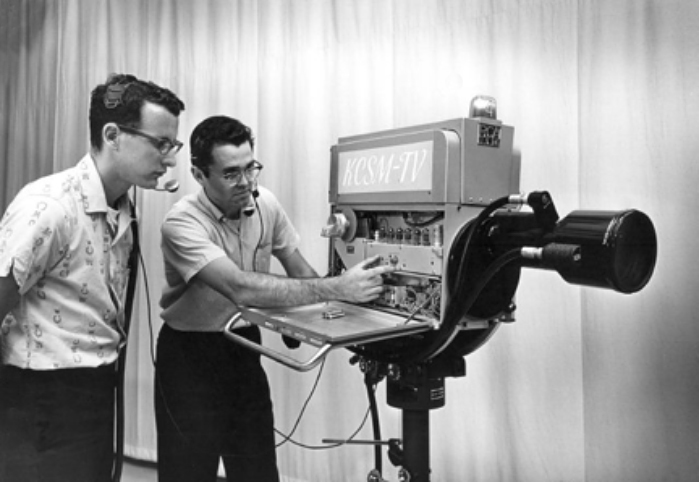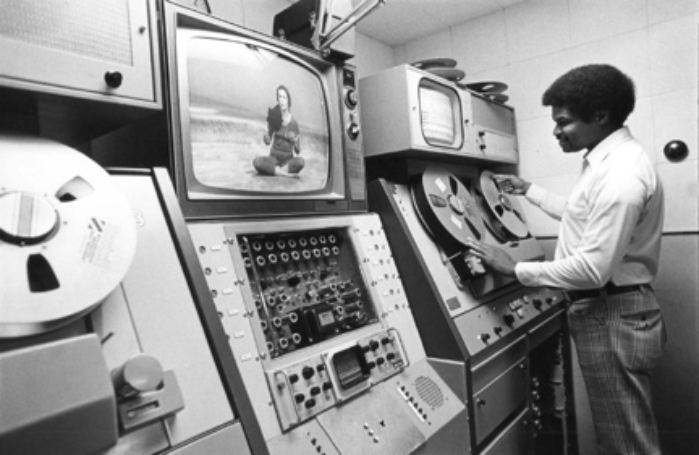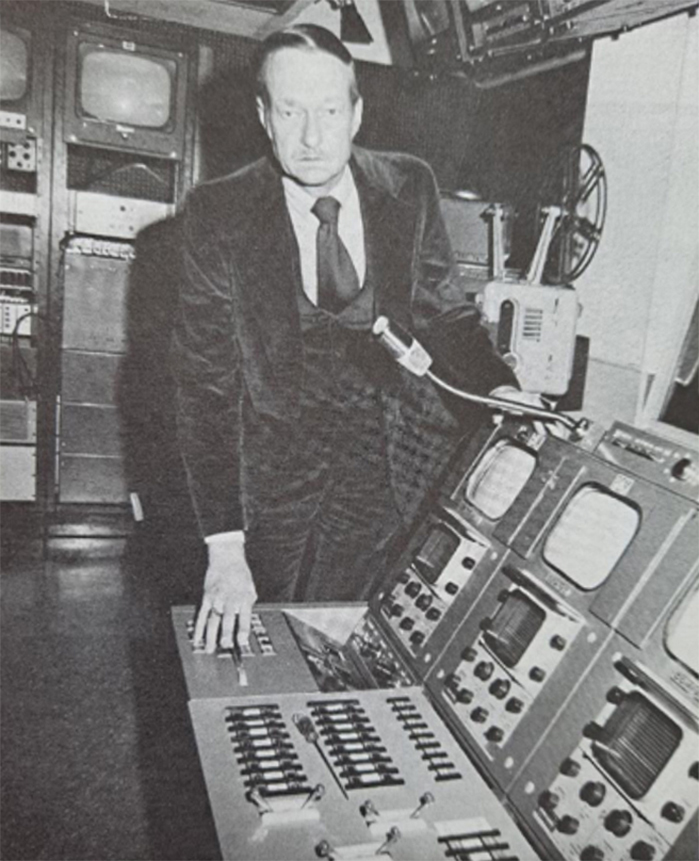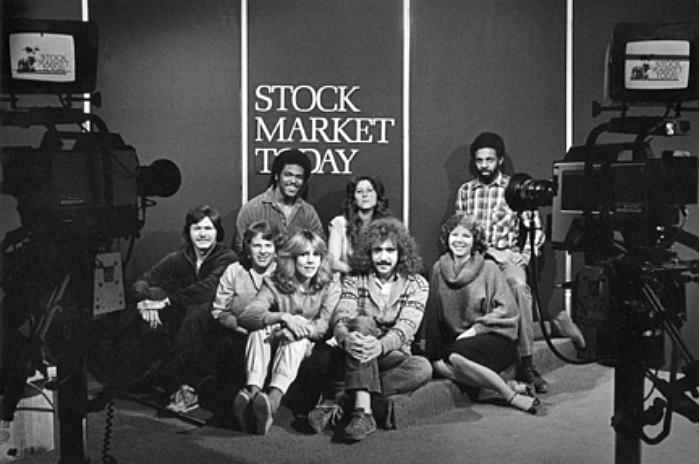KCSM-TV
Telecommunications program launched top talent and inspired community pride
College of San Mateo’s KCSM-TV went on the air October 16, 1964, as the second community college television station in America. A product of visionary CSM leadership at a prosperous time, KCSM Channel 14 (later Channel 60) and its sister station KCSM-FM anchored one of very few U.S. broadcasting departments that could put students live on an open-circuit station. For years, CSM was one of only three schools that the U.S. Information Agency listed for foreign students seeking broadcast training.
Talented students like Jon Miller, Claire Mack and Bonnie Chastain stepped directly from KCSM into major-market jobs. Innovative KCSM programming like the College Readiness Program’s ‘New Experience Project’ brought issues facing communities of color into many Bay Area homes for the first time.
KCSM-TV came about because college President Julio Bortolazzo envisioned a cutting-edge “people’s college” that reached beyond campus gates. As well as training broadcasters, Bortolazzo planned the station as a “College of the Air” with televised courses as a remote learning platform – even though UHF TV was so new in 1963, when College Heights opened, that most people on the Peninsula didn’t have UHF receivers.
Obtaining Channel 14’s FCC license took months of wrangling by Rep. J. Arthur Younger, R-San Mateo, a senior member of the House Interstate and Foreign Commerce Committee. (Younger also secured funds to extend Highway 92 to campus; the freeway is now named for him.) Prof. Jacob Wiens, the department’s chairman, pried needed state funds from bureaucrats who preferred a station in Southern California.
Wiens tasked KCSM-TV manager Doug Montgomery and his FM counterpart, Dan Odum, with duplicating a professional broadcasting environment in the classroom.
“As a student, you were trained to operate TV equipment,” said early graduate Rick Zanardi, who later became KCSM-TV’s general manager. “That’s pretty unique.
“I went to KGO-TV for a job interview,” Zanardi said, “and they had only one question: ‘What experience do you have?’ Right away I said I worked at KCSM, both TV and radio, camera, the whole thing. And that got me hired.”
Memorable synergies ensued as KCSM-TV and FM worked with CSM’s music department and with each other.
One long-running live series, “Opus 14,” brought in top jazz and classical musicians including visiting members of the Boston Symphony and touring Broadway shows. Zanardi recalled the first-chair bassist from Boston spending two hours at KCSM and playing a half-hour bass solo.
CSM music professors Fred Berry, Dick Cresta and Galen Marshall brought their students to play on the air live. As with other “Opus 14” programs, the audio was broadcast on KCSM-FM.
By 1975, CSM’s broadcasting program was capped at 450 students with a one-year waiting list. KCSM-TV broadcast up to 12 hours a day, seven days a week. But its black and white equipment was by then obsolete. Converting to color took years and was fantastically expensive at a time when funding sources were shrinking.
The move to color entailed exchanging Channel 14, high on the UHF dial and thus of great commercial value, with Spanish-language Channel 60. The latter’s owners offered their color equipment along with two years’ free rent on a broadcasting tower in San Bruno, enabling a much wider audience. A $300,000 grant from the U.S. Office of Education helped seal the deal, and KCSM-TV went color as Channel 60 on March 18, 1979.
College leaders all along intended KCSM-TV to be at least partly self-supporting. This meant pursuing grants, producing shows that other colleges or public TV stations would buy, or accepting money to produce shows for outside clients.
From 1978 to 1984, general manager Stewart Cheifet morphed KCSM-TV from a purely vocational platform to a more PBS-style operation.
“To expand, and to go color, we needed more funding,” Zanardi said. “We had to go out and sell our facility to outside operations. These people said they weren’t going to have students running their equipment, only professionals. So then there was no hands-on equipment. And we brought on paid workers.”
In particular, students and faculty griped about a horse-racing series sponsored by the Bay Meadows racetrack. College officials told reporters that the series benefited senior citizens, apparently because they had time to hang around the track.
Kathy Hoshijo’s “Kathy’s Kitchen” was picked up by 70 PBS stations nationwide. Also profitable was “Computer Chronicles,” developed in part by SRI and sponsored by the retailer Computerland, which chipped in a satellite dish to the deal.
In 1982, an 18-month FCC pilot program allowed KCSM-TV and nine other public stations to raise needed revenue by airing commercials. KCSM was the only public TV channel west of Chicago authorized to sell airtime. Its first ad was for Marine World Africa USA.
In 1982-83, as the San Mateo Community College District faced a $3 million deficit and community colleges statewide mulled a $50/semester fee for the first time, some people in the CSM community began asking if KCSM-TV was viable long-term. KCSM was then raising 70 percent of its total budget. But it still wasn’t enough.
In 1986, KCSM-TV pulled its finance series “Stock Market Report” after the outside funder who dictated its content was named by the Los Angeles Times in a pay-for-play scandal: Two recent guests had been jailed on federal securities violations. The cancellation cost CSM $100,000 a year.
The 1990s saw a providential donation from alumnus Ray Daba, a lawyer and member of the state Board of Education who said, “Providing these gifts is a way of repaying the college for the opportunities it gave me.” But KCSM-TV faced another reckoning when digitization swept the industry in the early 2000s.
“We had to pay again and the expenditure was quite high,” Zanardi said. “We decided to reincorporate the students back into the program. Not 100 percent, but enough that they could produce and air their TV programs on KCSM. In 2014, the electrical bill was $12,000 a month for transmission alone.”
Having multiple PBS stations in the area was daunting, Zanardi said, and CSM “after a lot of thought decided to terminate operation of the station.”
Today, CSM’s broadcasting programs operate in the department of Digital Media, along with multimedia, journalism and graphic design. District trustees sold the station in 2018.







